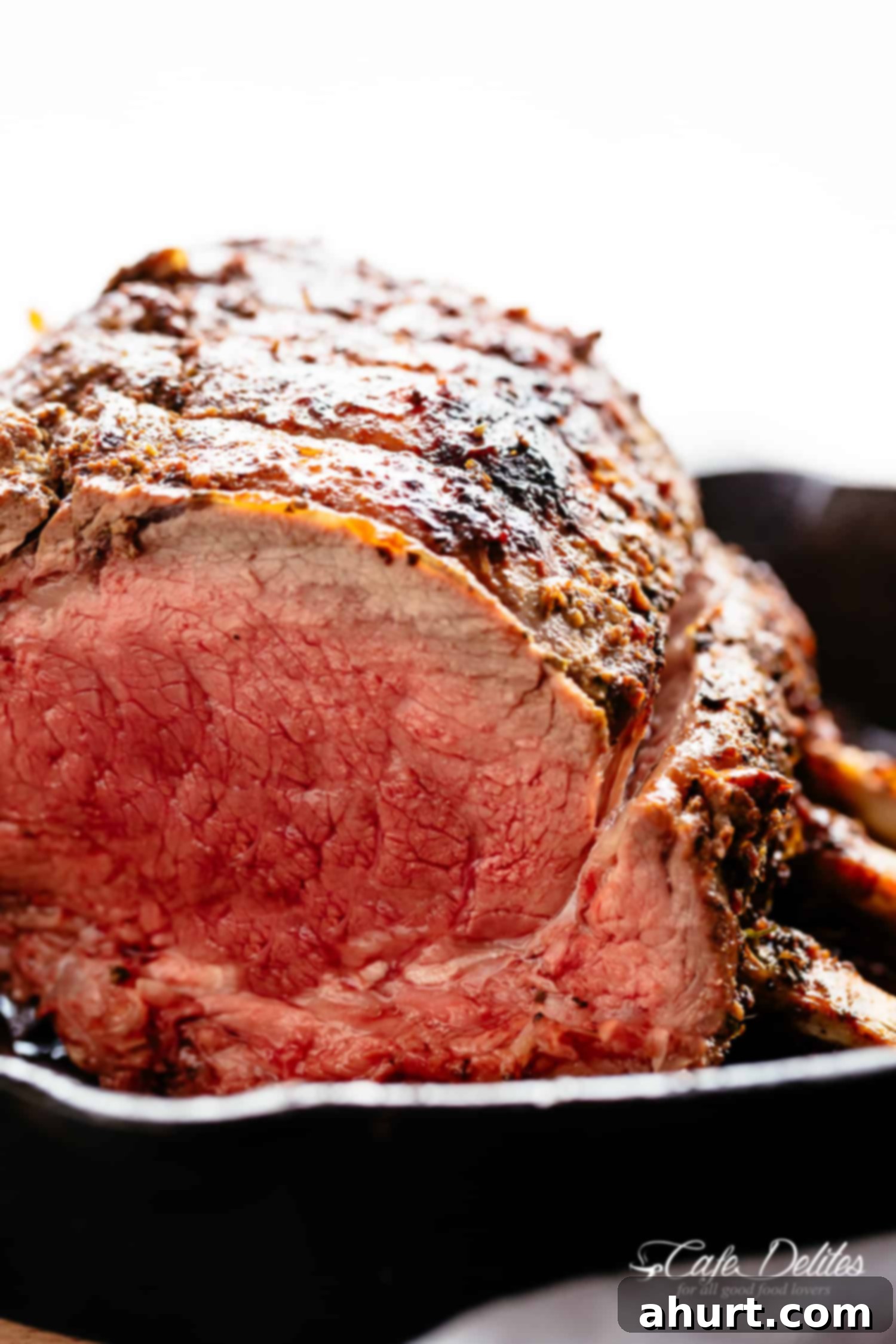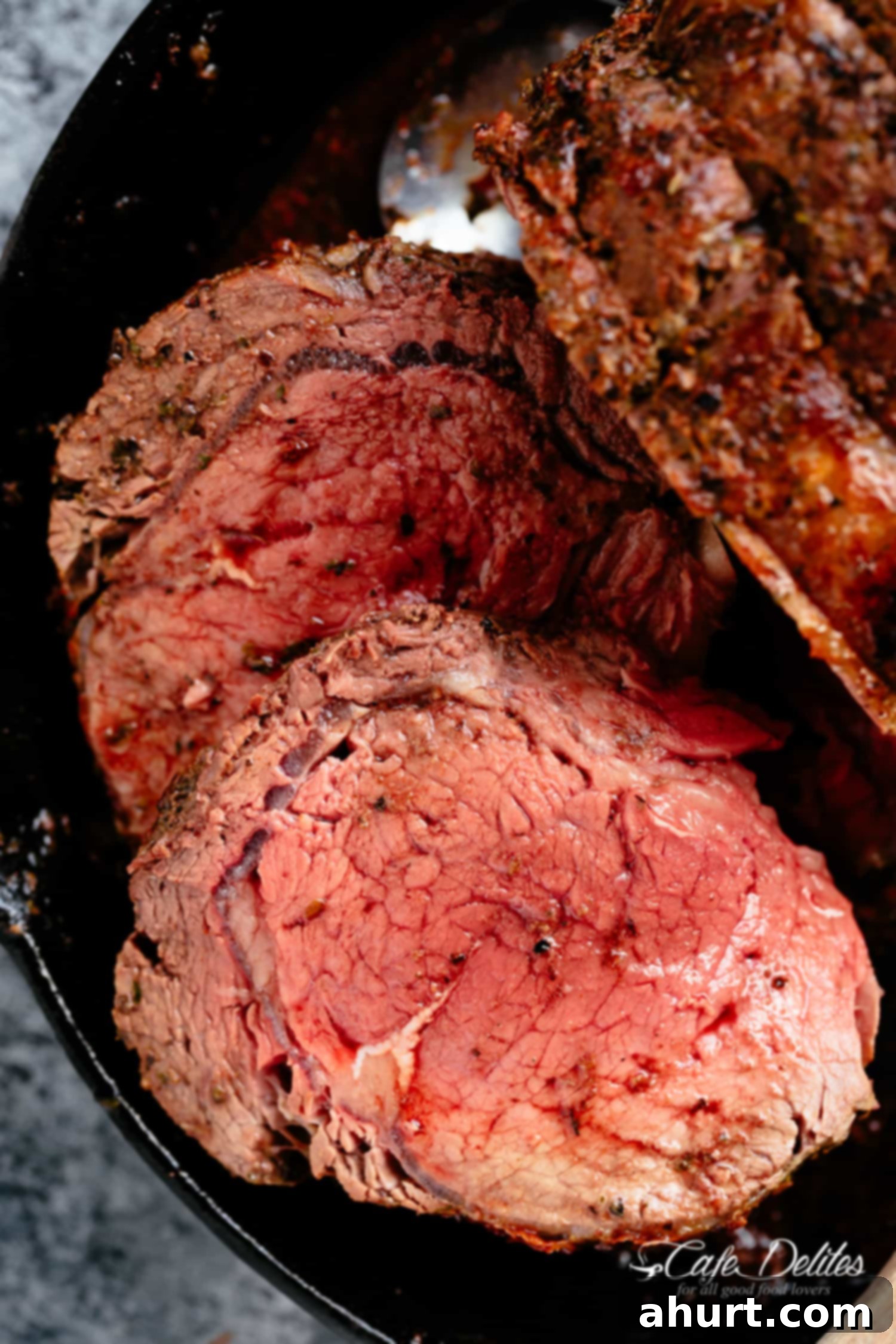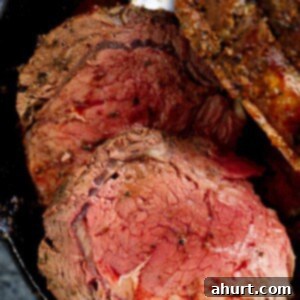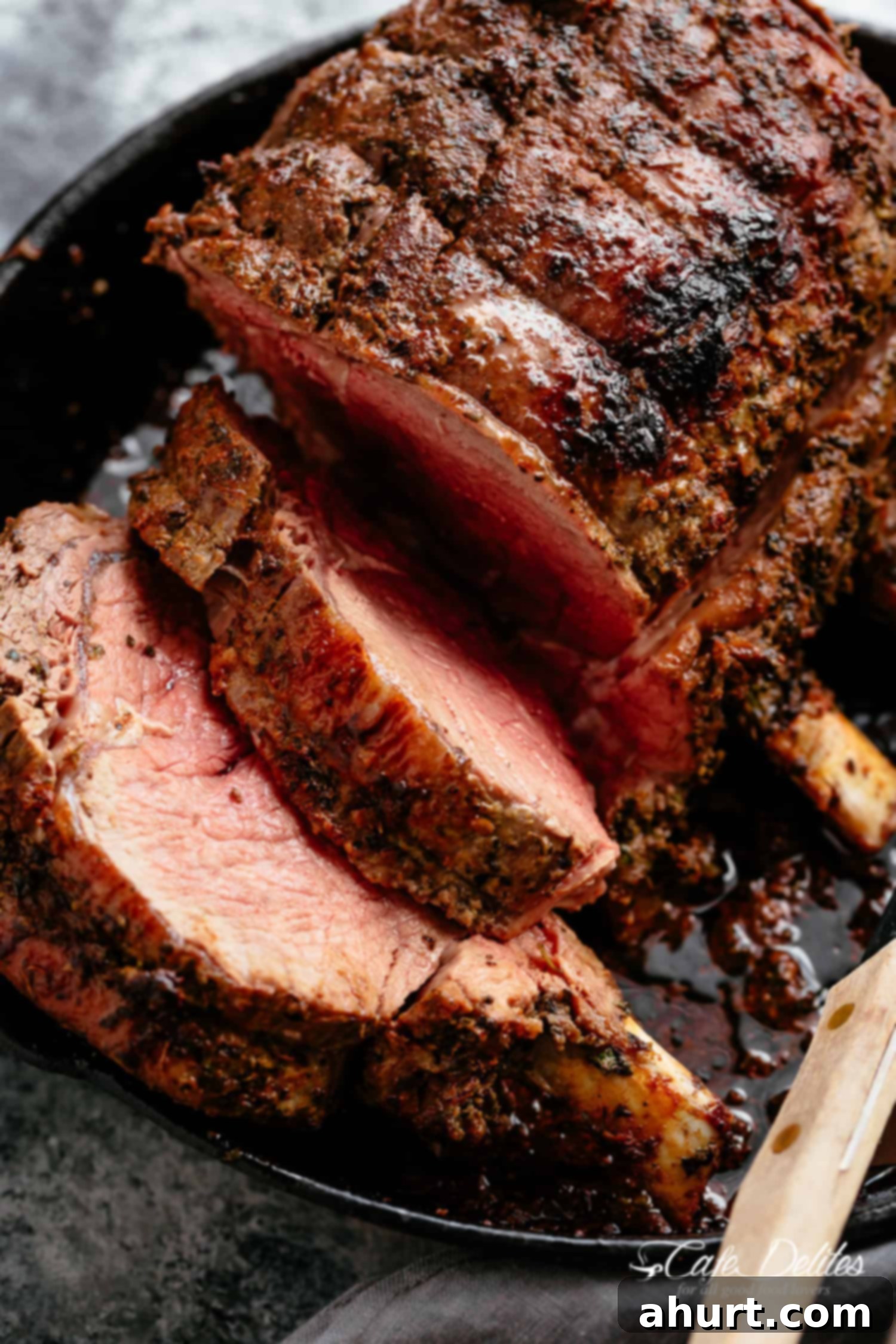Mastering the Ultimate Garlic Butter Herb Prime Rib Roast: Juicy & Flavorful for Any Holiday Feast
Elevate your holiday table with a spectacular Garlic Butter Herb Prime Rib Roast. This magnificent centerpiece is bursting with flavor, incredibly juicy, and surprisingly efficient to prepare, making it the perfect showstopper for Christmas lunch, dinner, or any special gathering. Forget long hours in the kitchen; with our method, you can achieve a melt-in-your-mouth interior and a gloriously browned, herb-crusted exterior with less fuss than traditional roasts.
Imagine a prime rib so tender it practically melts, coated in a rich, aromatic garlic and herb butter that crisps into a golden crust during roasting. This isn’t a dream; it’s a reality with this recipe. While some traditionalists might raise an eyebrow at a prime rib method that streamlines the cooking process, we’ve perfected a technique that delivers exceptional results without the excessive wait. It’s a testament to achieving maximum flavor and tenderness with minimal effort, ensuring your prime rib is nothing short of perfect every single time.
POST UPDATED WITH VIDEO!
What Makes Prime Rib the Ultimate Centerpiece?
Also known as a Standing Rib Roast, prime rib is a truly special cut of beef that promises an unforgettable dining experience. Your family, friends, or guests will undoubtedly fall in love with this beautiful piece of meat, especially when it’s infused with a rich, buttery, garlicky herb mixture that not only creates a crispy, golden-brown crust but also tenderizes and flavors the meat from within. This luxurious cut is renowned for its exceptional marbling, which contributes significantly to its natural tenderness and incredible juiciness, ensuring every slice is packed with rich, beefy flavor.
When selecting your prime rib, you’ll find options for both bone-in and boneless roasts. While boneless cuts are easier to carve, a bone-in roast consistently yields the best results. The bones act as natural insulators, protecting the meat from drying out during cooking and contributing to a more even roast. They also impart additional flavor to the meat, leading to a guaranteed juicy, succulent, and more flavorful outcome.
What Cut of Meat is Prime Rib?
A prime rib roast is cut from the primal rib section of the cow, specifically from the back of the upper rib cage. This section typically contains seven ribs. For our Garlic Butter Herb Prime Rib recipe, a 4-bone rib roast is ideal. This size strikes a perfect balance, providing enough meat to feed a gathering while remaining manageable for home cooking. The term “standing rib roast” refers to the traditional method of roasting it upright on its bones, allowing them to form a natural rack.

The Secret to a Perfectly Cooked Prime Rib: Our Efficient Method
While prime rib may be an investment, its naturally tender, juicy, and melt-in-your-mouth quality makes it well worth the price for feeding your guests around a dinner table. Our method ensures you achieve these desired characteristics without overcomplicating the process. The key lies in an initial high-heat sear followed by a controlled lower temperature roast, locking in juices and developing that irresistible crust.
Preparation Steps for Success:
- Bring to Room Temperature: Remove your prime rib from the refrigerator at least 30 minutes, and ideally up to 2 hours, before cooking. This crucial step allows the meat to cook more evenly, preventing the exterior from overcooking while the interior remains cold.
- Preheat Your Oven: Ensure your oven is fully preheated to 450°F (230°C) for at least 30 minutes before the roast goes in. A piping hot oven is essential for achieving that initial, flavorful crust.
- Positioning the Roast: Place the bone-in roast in a sturdy cast iron skillet or a roasting pan bone-side down. The bones act as a natural roasting rack, lifting the meat slightly off the pan and allowing for even air circulation and browning.
- The Garlic Herb Butter Magic: This is where much of the flavor comes from. Generously pour the prepared garlic herb butter mixture over the meat. Take your time to rub it into the flesh, ensuring it coats every surface evenly. Don’t forget to season with a little extra salt and pepper for enhanced flavor before roasting.
- The Roasting Technique:
- Initial High-Heat Sear: Roast uncovered for the first 30 minutes at 450°F (230°C). This high heat creates a beautiful, char-grilled coated flavor and a crispy crust.
- Lower Temperature Roast: After 30 minutes, reduce the oven temperature to 375°F (190°C). Cover the roast loosely with foil and continue roasting until it reaches your desired internal temperature. Covering helps to prevent excessive browning and keeps the meat moist.
As enthusiasts of truly tender beef, we prefer our prime rib cooked to a perfect medium-rare, showcasing its full flavor and melt-in-your-mouth texture. However, you can certainly continue roasting to achieve your preferred level of doneness, from rare to medium-well.

How Long Do You Cook a Prime Rib & Achieving Perfect Doneness?
The most critical tool for cooking prime rib is a digital meat thermometer. Whether you opt for a leave-in probe thermometer or a quick-read stick thermometer, it provides unparalleled accuracy, eliminating guesswork and preventing the ultimate tragedy: overcooked prime rib. Internal temperature is the only reliable indicator of doneness.
Our method involves an initial 30-minute cook at 450°F (230°C). After this, reduce the oven temperature to 375°F (190°C), cover the roast with foil, and continue cooking until your meat thermometer registers the following temperatures (remembering that carryover cooking will raise the temperature further during resting):
- Rare: 110°F (43°C)
- Medium-Rare: 120°F-125°F (48°C – 52°C) – *This is our preferred doneness.*
- Medium: 130°F-135°F (55°C – 57°C)
- Medium-Well: 140°F (60°C)
Once your roast reaches your desired temperature, remove it from the oven immediately. Resting is non-negotiable! Tent the roast loosely with foil and allow it to rest for at least 20-30 minutes before carving. During this resting period, two crucial things happen:
- The internal temperature will continue to rise by 5-10 degrees (this is called carryover cooking). For example, if you pull your roast at 120°F for medium-rare, it will rise to a perfect 125°-130°F.
- The juices, which have been pushed to the center of the roast during cooking, redistribute throughout the meat, resulting in a significantly juicier and more tender final product. Slicing too early will cause these precious juices to escape onto your cutting board.
What to Serve With Prime Rib Roast
For an easy yet elegant Christmas lunch or dinner, serve this spectacular Garlic Herb Prime Rib Roast with a selection of delicious, crowd-pleasing sides. Don’t forget to capture the flavorful pan drippings to create a rich au jus or gravy!
- Garlic Parmesan Scalloped Potatoes: Creamy, cheesy, and utterly decadent, these potatoes are a classic pairing for prime rib.
- Creamy Mac and Cheese: A comforting and rich side dish that’s always a hit with guests of all ages.
- Creamy Mashed Potatoes: Smooth, buttery mashed potatoes are the perfect vehicle for soaking up all the savory juices.
- Balsamic Chickpea Avocado Feta Salad: A lighter, refreshing option to balance the richness of the meat.
- Roasted Broccoli & Green Beans: Simple, flavorful, and a great way to add some vibrant greens to your meal.
With minimal effort, you can create the BEST prime rib your family and friends will ever taste! Easy to carve, this recipe promises PERFECT results every single time, making you the hero of any holiday feast.
MORE HOLIDAY RECIPES!
Looking for more festive culinary inspiration? Explore these delightful holiday recipes to complete your spread:
- Glazed Ham Recipe: A sweet and savory alternative or addition to your holiday table.
- Antipasto Cheese Ball Christmas Tree: A fun and festive appetizer that’s as delicious as it is decorative.
- Garlic Herb Butter Roast Chicken: A simpler but equally flavorful roast, perfect for smaller gatherings or as a secondary protein.
NOW ON VIDEO!
Watch our step-by-step guide to making this incredible Prime Rib Roast to ensure your success in the kitchen!

Saved
Pin
Prime Rib
Ingredients
- 6 pounds standing rib roast (4 bone rib roast)
- 4 tablespoons melted butter (or olive oil for a dairy-free option)
- 6-8 cloves garlic (large, minced or finely chopped, about 2 tablespoons minced garlic)
- 1 tablespoon fresh oregano (finely chopped, or 2 teaspoons dried)
- 1 tablespoon fresh parsley (finely chopped, or 2 teaspoons dried)
- 2 teaspoons fresh Thyme (finely chopped, or 1 teaspoon dried)
- 2 teaspoons fresh rosemary (finely chopped, or 1 teaspoon dried)
- 1 tablespoon kosher salt
- 1/2 tablespoon black pepper
Instructions
-
Preheat your oven to 450˚F (230°C) for at least 30 minutes while the prime rib comes to room temperature. This ensures an even cook and a good crust.
-
In a small bowl, thoroughly mix together the melted butter (or olive oil), minced garlic, all the fresh (or dried) herbs (oregano, parsley, thyme, rosemary), 1 tablespoon of kosher salt, and the black pepper until well combined. This is your flavorful herb butter rub.
-
Place the standing rib roast in a cast iron skillet or a sturdy roasting pan with the bone-side down. The bones will serve as a natural roasting rack, lifting the meat slightly. Pour the prepared garlic herb butter mixture over the meat, generously rubbing it into the flesh to ensure it’s coated well and evenly on all exposed surfaces. Feel free to season the entire roast with a little extra salt and pepper for an even deeper layer of flavor.
-
Cook the roast uncovered for the first 30 minutes at 450°F (230°C). This high-heat blast creates a fantastic crust. After 30 minutes, reduce the oven temperature to 375°F (190°C). Cover the roast loosely with aluminum foil and continue to cook until your meat thermometer reads 110°F (43°C) for rare. For the pictured medium-rare roast, we continued cooking for an additional 45 minutes, covered. Adjust cooking time based on your desired doneness (refer to the doneness guide above).
-
Once the roast has reached your desired internal temperature, remove it from the oven and allow it to rest for a full 20-30 minutes, loosely tented with foil. This resting period is crucial, as the roast will continue to cook (carryover cooking), raising the internal temperature by several degrees to reach a perfect 125°F-130°F (52°C-55°C) for medium-rare. More importantly, it allows the juices inside the meat to redistribute, ensuring every slice is incredibly tender and juicy. After resting, carve and serve immediately.
Notes
*If you choose to season your roast the night before, refrigerate the roast uncovered overnight. This allows for a deeper flavor penetration and helps dry out the exterior slightly, promoting a crispier crust. Remember to allow it to come to room temperature for at least two hours before placing it in the oven for optimal even cooking.
Nutrition
Carbohydrates: 2g |
Protein: 46g |
Fat: 31g |
Saturated Fat: 9g |
Polyunsaturated Fat: 2g |
Monounsaturated Fat: 8g |
Trans Fat: 0.4g |
Cholesterol: 145mg |
Sodium: 1.044mg |
Potassium: 786mg |
Fiber: 0.5g |
Sugar: 0.1g |
Vitamin A: 272IU |
Vitamin C: 2mg |
Calcium: 77mg |
Iron: 2mg
Nutrition information is automatically calculated, so should only be used as an approximation.
